Abstract: This article explores how the film Toomelah (2011) by Australian Indigenous filmmaker Ivan Sen amounts to an affirmation of the values of intercultural dialogue between peoples who do not always see the world in the same ways as each other. A descendant of the Gamilaroi [1] people of northwest New South Wales and also of Hungarian, German, and Croatian descent, Sen’s film operates “at the intersections of two or more cultural regimes of knowledge” and speaks to indigenous/ settler, local/national and international/global cinematic relation. [2] By engaging in bordering activity, Toomelah negotiates such binaries to visualise a disruptive, postcolonial space: a borderland in need of a border. Analysing Sen’s visualisation of the land and landscape of Indigenous peoples whose sense of belonging to a nation is otherwise ignored or denied, I ask if Sen can be understood as a sojourner in his own nation engaged in a practice that frames borders as a site of potential cultural encounter rather than of exclusion.
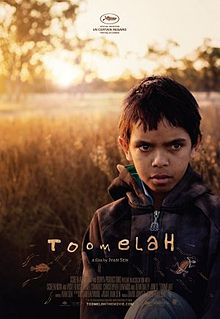
Toomelah poster [3]
Introduction
This article was engendered by an interest in “sojourner cinema”. [4] In brief, sojourner films are by outsider or visiting directors who cross borders to make a film in and about another nation. My interest lies in exploring what these films can tell us about cosmopolitanism and hospitality, that is, about the relationship between guest and host, or “friendship with strangers” as the ethicist Kwame Appiah terms it. [5] My concern is to see if, and if so how, cinema participates in recognising and valuing local particularities and, at the same time, in accepting universal values and obligations. My focus is the Indigenous filmmaker Ivan Sen’s third feature film, Toomelah (2011): I explore what this film shows and tells us about the significance of borders for Australia’s First Nations and the possible need to resurrect them. [6]
Sojourner Cinema
Sojourner cinema is a concept that I am in the process of defining and refining. I do not have a fixed view of its ontological dimensions and suspect that there may be nothing very fixed about it at all. Until recently, my understanding of it as a cinematic category has been in alignment with contemporary disciplinary concerns to blur borders, and an academic preoccupation with mobility, identity and otherness. Sojourner filmmakers are mobile, they travel and cross national borders to engage in transnational, cross-cultural, filmmaking practice. They do not, however, travel involuntarily as do many – perhaps most – exilic, refugee, diasporic, and post-colonial filmmakers as discussed by scholars such as Hamid Naficy and Laura Marks. [7] While sojourner films are often “place-bound” they also operate “at the intersections of two or more regimes of cultural knowledge” to use Laura Marks’ invaluable phrase. [8] They do not, however, belong to the world’s “precariat” of contingent cultural labour who are forcibly “displaced” or “dislocated”, who yearn for a faraway home, and who intend (often have no option but) to make a new home in the nation in which they make their films. [9] In short, sojourner filmmakers are privileged: they have a return ticket and they stay as a guest in another nation only for as long as it takes for them to make a film in and about their host nation. It is this aspect of guest and host, of friendship between strangers, that suggests the concept of sojourner cinema could reveal something valuable about what borders theorist Chris Rumford calls “the ‘cosmopolitanization’ of borders whereby actors other than the state can be involved in bordering activity.” [10]
The concept of sojourner cinema is also informed by ethnographic filmmaking concerns. Following the ideas of Bertrand Westphal who introduced the notion of “geocriticism”to describe literary analysis that incorporates geographic space, sojourner films offer a multiperspectival approach. First, they present an endogenous point of view or voice that characterises the ‘other’ (the autochthonous “other” in the case of the First Nation peoples of Australia). [11] Second, they present the filmmaker’s own, exogenous, perspective in that their outsider’s vision and voice is present in their films. Third, they present an allogeneous voice and vision, that lies somewhere between the first two perspectives and which, as Westphal writes, “is characteristic of those who feel at home in a place, become familiar with it, but who nevertheless remain foreigners in the eyes of the indigenous population.” [12]
Sojourner cinema is a filmic category that fills a scholarly gap between the territory of “national cinema” and the more fluidly located cinemas for which Thomas Elsaesser uses the term “double occupancy”, Naficy calls “accented” and Marks names “intercultural”. [13] Because sojourners’ films often fall outside the concerns of much contemporary film analysis, their relationship to each other often remains unnoticed and their import for understanding how a significant number of filmmakers engage in a bordering practice to depict :otherness” remains unexplored. If intercultural cinema offers a means of discovering and listening to more than one voice, and national cinema offers a means by which the local and the transnational reconfigure each other, then as Hilary Radner notes, the notion of sojourner cinema offers “a useful heuristic device [that] enriches our understanding of how cinema travels and negotiates identity”. [14]
First Nation Cinema
It may seem surprising – inappropriate, even – to locate the films of an Aboriginal filmmaker made in and about an Aboriginal community within the category of sojourner cinema. As a descendant of the Gamilaroi people of northern New South Wales who were historically dis-located from their own land and forcibly re-located, Sen’s films are undoubtedly intercultural, diasporic, and postcolonial and as such, qualify as accented and intercultural cinema. [15] However, I do not propose to ignore or challenge Marks’ and Naficy’s critical and analytical frameworks. Rather, I acknowledge them as invaluable starting points for my own research. Their scholarship invites me to explore Sen’s film by opening the way to consider three interrelated aspects of contemporary cinema: first, the implications of Sen’s film involving more than one perspective and more than one voice; second, the nature of the intercultural or accented dialogue that imbue the words and images in this film; and last, how Toomelah shows that for this First Nation filmmaker, as Rumford writes, borders “do not have to be visible in order to be effective” and “can exist for some (but not for all), and can link people to the world beyond the ‘local’ border”. [16]
Sen: His Heritage
Sen’s mother, a Gamilaroi woman, was born and grew up in Toomelah, a small community, originally a Pentecostal mission, in New South Wales on the Macintyre River that marks the State boundary between New South Wales and Queensland. Born in 1971, Sen first lived about 60kms upstream from Toomelah in Queensland with his mother Donella and his father, Duro Sen, a tobacco farm worker of German-Hungarian origins. From the mid-1970s Ivan lived first in Tamworth, NSW with his mother and sister, and from 1984 in Inverell, NSW where his stepfather edited the local newspaper, The Inverell Times [17]. As a child, from time to time Sen visited Toomelah where he still has relatives.
Toomelah is the third place to which the Gamilaroi people have been relocated by the state since Australia was settled by the English. At its present location, Toomelah came into existence in 1937 when the Gamilaroi people were relocated from Old Toomelah some 100kms to the south, and deposited here in trucks with people from the neighbouring Bigambul nation who were similarly dislocated from their traditional homelands and forcibly relocated to the same place. [18] Historically, these two peoples comprised two distinct language groups, or nations, although they shared some aspects of their cultures. For example, the now extinct Bigambul language and its Gambuwal and Kwiambal (or Gujambal) dialects was the traditional language of the Bigambul people but it is likely that the Gamilaraay (or Yuwaaliyaay) language of the Gamilaroi nation was also used by those peoples living in southern Bigambul territory. [19]
The traditional lands of the Gamilaroi nation, are marked on the following map (here marked ‘Kamilaroi’). Those of the Bigambul nation, were immediately to the north and north west mostly in what is now Queensland.


Gamilaroi (marked Kamilaroi) traditional lands area in New South Wales [20]
The Gamilaroi and Bigambul nations are just two of several Indigenous nations in this region on the east Australian coast, as the next map shows:
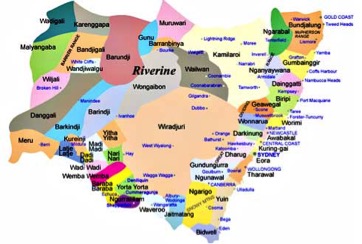
First Nations and language groups of New South Wales, Australia [21]
These Indigenous nations of New South Wales are just some of between 350 and 750 First Nations in the whole of Australia (including the Torres Strait Islands), each with its own language or dialect and culture as well as some shared aspects of culture and societal structure, that existed for from between 40,000 – 60,000 years until the late 18th century when the English colonialists first arrived in 1788, as shown in the next map: [22]
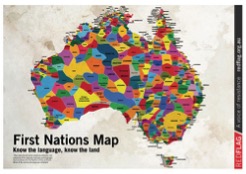
First Nations Map, Australia [23]
These maps, of course, employ a pictorialisation of Indigenous nations using Western mapping techniques and ideas about borders. The actual borders between these nations and language groups were more fluid than suggested by the solid lines around distinct areas on a map. As historian Bill Gammage writes, citing the anthropologist William Stanner, it is unlikely that the bounded nations on these maps coincide precisely with Aboriginal words that may mean “nation”, “camp”, “hearth”, “country”, “everlasting home”, “totem place”, “life source”, “spirit centre” and much else all in one. [24] In some aspects, however, the borders between Indigenous nations were were at the same time, also well defined. Discussing First Nation borders before colonial settlement, Gammage explains: “The right to say who could enter country was the decisive expression of legitimate possession.” Gammage cites the pioneer settler James Dawson who in 1881 published Australian Aborigines: The Languages and Customs of Several Tribes of Aborigines in the Western District of Victoria, Australia in which he writes: “No individual of any neighbouring tribe or family can hunt or walk over the property of another without permission of the head of the family owning the land. A stranger found trespassing can legally be put to death”. [25]
English explorer Edward Eyre who led expeditions in South Australia and together with his Aboriginal companion, Wylie, was the first European to traverse the coastline of the Great Australian Bight and the Nullarbor Plain by land in 1840-1841. He also wrote about the Indigenous borders that he encountered:
particular districts… are considered generally as being the property and hunting-grounds of the tribes who frequent them. These districts are again parcelled out among the individual members of the tribe. Every male has some portion of land, of which he can always point out the exact boundaries… Tribes can only come into each other’s districts by permission, or invitation, in which case, strangers or visitors are well treated. [26]
Concepts of Indigenous nation and borders were, and are, both more fluid and more fixed than conventionally envisaged. As environmental philosopher and anthropologist Deborah Bird Rose writes, for Australia’s indigenous peoples, each country was;
Surrounded by other countries, so that across the continent and on into the seas, there is a network of countries. No country is ruled by any other, and no country can live without others. It follows that no country is the centre toward which other countries must orient themselves, and equally, that each is its own centre. [27]
As Gammage concludes:
The literate habit of fixing boundaries imposes an illusory rigidity on 1788 [when the First Fleet landed at Port Jackson and established the penal colony of New South Wales]. Spirits of totems limited where someone could go, but generally the boundaries of country were permeable. Almost everyone had rights and interests in other countries… The right to say who could enter country was the decisive expression of legitimate possession. [28]
But however more and less fluid and fixed, the Indigenous nations’ borders were systematically ignored or obliterated, often violently, by the British colonisers who were politically and economically invested in the founding legal fiction, or lie, of terra nullius that declared the land belonged to no-one. [29] As a direct outcome, today fewer than 150 Indigenous languages remain in daily use and, apart from about 20 of these, all are vulnerable or critically endangered. [30] I deliberately emphasise these nations, this aspect of their culture, their language, that is already extinct or is disappearing, and borders, as these are important to my argument and I return to this issue later in this article.
Toomelah
Toomelah first came to national public notice in 1987 when Justice Marcus Einfeld led a Human Rights Commission Inquiry and visited the town to investigate conditions after a race riot in the nearby town of Goondiwindi, Queensland. According to a Sydney Morning Herald story of 2008, he found that:
Toomelah had one water tap for 500 people, and it flowed twice a day for just 15 minutes. Some houses had 30 people sleeping in them, and Goondiwindi High School, just across the border, had a blackboard for the whites and a blackboard for the blacks. And when the children came home, they played in the raw sewage of Toomelah’s fetid, fouled streets. [31]
Einfeld reportedly “turned the spotlight on neglect by walking with his trousers rolled up through the muddy, soiled streets of Toomelah and crying tears of shame and pity.”

Marcus Einfeld stepping through the muddy streets of Toomelah in 1987. [32]
Twenty years later the Sydney Morning Herald reported that conditions were no better and that “Toomelah’s water remains unsafe to drink.” In 2012, conditions had still not improved and there were rumours that the community was to be forcibly relocated once again: “When the Herald visited last week, sewage pooled in the open between houses, numerous buildings were gutted by vandals, rubbish littered the streets, and residents talked of multiple suicide attempts each month.” [33] To this, NSW Aboriginal Affairs Minister Victor Dominello responded: “The situation in Toomelah is shocking and heartbreaking. It cannot be acceptable to any government or any community leader.’’ [34]
The community today comprises about 300 Indigenous people. [35] There’s no longer a store as it burned down a couple of years ago: the nearest shop, a small general store, is about a two-hour walk away at Boggabilla (population 626 in 2011). The Community Health Services offers limited health care from visiting medics. There is a primary school of approximately 45 students, all of whom are Aboriginal and who are taught by white teachers supported by Aboriginal teaching assistants. The Community Engagement Leader teaches Gamilaraay. The community is proud of its Koori Rugby team, the Toomelah Tigers.
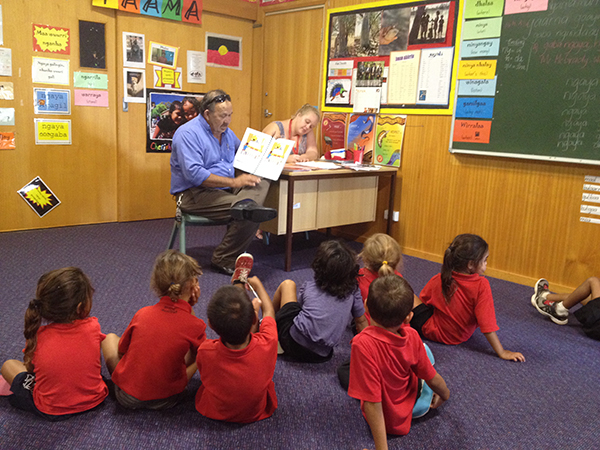
Learning Gamilaraay at Toomelah Public School, 2015. [36]
Ivan Sen: The Filmmaker
Sen is not only Australia’s most prolific Indigenous filmmaker, he is one of Australia’s most prolific filmmakers. [37] In addition to many shorts, he has made four drama feature films and a one-hour documentary in the past 12 years; he is currently in production on his fifth feature film and in development for a television series. “Director”, is an inadequate description for this filmmaker: Sen is a “multihyphenate” as Variety once dubbed him. [38] On Toomelah, he was writer, director, cinematographer, editor and sound designer. He also composed the music and designed the sound, as he has for all his films.

Ivan Sen with lead actor Daniel Connors on location, Toomelah. [39]
In their various ways, all Sen’s films are about or comment on the impact of location, dislocation and relocation upon identity: land, landscape, place, space, and belonging are crucially important throughout his oeuvre. His first feature, Beneath Clouds (2002), is a road movie in which one Aboriginal teenager leaves home and another tries to return home. Sen says he made it because he was “always interested in people searching for something that makes them believe they belong somewhere [else]”. [40] His documentary feature, Yellow Fella (2005), follows Indigenous actor Tom E. Lewis, the Aboriginal actor and musician who first found fame as the lead in The Chant of Jimmie Blacksmith (Fred Schepisi, 1978), as he traces his mixed heritage to Arnhemland in northern Australia to find his Welsh father’s grave and his own identity. Sen’s second feature, Dreamland (2009), is a visually wondrous, experimental film in which a UFO hunter journeys obsessively across the Nevada desert searching the skies for contact and for his identity and location to be confirmed. His most recent feature, Mystery Road (2013), is a murder mystery-western hybrid loosely based on events in Sen’s own family history about an Indigenous outback detective (Aaron Pedersen) who hunts down the killer of Aboriginal girls. In an article entitled ‘Outsider knowledge in Ivan Sen’s Mystery Road’, the Australian reports:
Lost black girls have haunted Sen’s creative output. In 2004 his documentary Who Was Evelyn Orcher? investigated the abduction of his grandmother’s sister as a child from her home in Toomelah, NSW, in 1949. In this case, Orcher, a member of the Stolen Generations, was not taken by a random stranger but by government welfare workers. In his 2007 documentary A Sister’s Love, he documented [Indigenous] director and actor Rhoda Roberts’s hunt for answers after her twin sister Lois’s remains were found in Whian Whian State Forest, northeast of Lismore, NSW, in 1999. [41]
Referring to Sen’s personal family history and his Chinese wife, the Australian continues:
He remains… that lonely Inverell schoolboy caught between competing worlds. He spends his time between Chengdu, in Sichuan province (where he’s pitching… a “CGI, romance action, sci-fiction film set in a future city”) and Moree, Brisbane and Sydney, and admits he feels like an outsider wherever he is. “Even when I’m there, with my Chinese family, I’m not there. It’s just too much up here” – he taps his head again, grimacing. “It’s hard. It’s like you’re always chasing something. In some ways being an outsider can be quite amazing because you get to see the truth of these two different worlds, but it’s also a lonely place.”
Significantly, before becoming a film director Sen studied photography at art college in Brisbane where he specialised in the genre of location portraiture. The power of this genre can be seen in all his films in which landscape informs and frames people, and people inhabit and inform the landscape in which he films them.
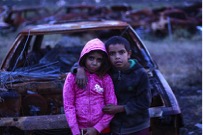
Trashed carscape: Daniel (Daniel Connors) and girlfriend, Tanitia (Danieka Connors) [42]
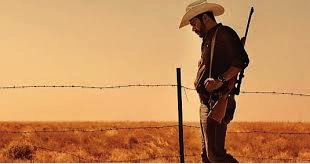
Outback borderland: Aaron Pedersen in Mystery Road. [43]
When people are absent from Sen’s camera frame, the image speaks of their displacement and the borderlands that they inhabit or traverse. Of the land around Winton in Queensland (pictured below) where he largely filmed Mystery Road, Sen says: “I think it’s the variation in the landscape which initially attracted me, if I really think about it I don’t think I’ve seen such a varied landscape in the world.” [44] .”
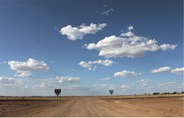


Landscapes in Mystery Road. [45]
Toomelah: The Film
Toomelah is an imaginative hybridisation of documentary and fiction. Sen wrote the script based on a fusion of his ideas and the words, ideas, emotions, impressions and imaginings of the Toomelah inhabitants who talked to and from whom he cast as the actors. (The single outsider [and sole professional actor] is Dean Daley-Jones who plays a mean gangster who has been away in jail for some years). The story is told through the eyes of ten-year-old Daniel (Daniel Connors) who dreams of being a gangster when he grows up and is far from averse from making at start right now. Kicked out of school for violent and recalcitrant behaviour, Daniel gravitates towards Linden (Christopher Edwards), the charming, if often stoned and violent, local drug dealer-gangster. When rival dealer Bruce arrives back from jail to reclaim his turf, an outburst of extreme violence and a drug bust ensue. Caught in the middle, Daniel is forced to make a choice about his highly uncertain future. Through all this, Daniel also has to make sense of his stoned mother, an alcoholic father, a girlfriend Tanitia (Danieka Connors) who plays very hard to get, and a great-aunty who returns to Toomelah after years of living in Sydney. She’s a member of the Stolen Generations, one of the many Aboriginal children who throughout most of the twentieth century were forcibly removed from home and family. [46]
The film portrays the people of Toomelah as a community that is immobilised. They’re stuck in a space behind borders that are no longer recognised by the State, unable to speak their own language, practice their traditional customs or participate meaningfully in the nation’s dominant white society and culture. Enclosed in a local community they are outsiders in what was once their own nation. While the borders of the Gamilaroi and Bigambul nations today are but a memory of a line in the shifting sands, in many ways they remain real to the inhabitants of Toomelah. This reality of existing in a nation without the borders that once protected their culture and which are denied or ignored by the rest of Australia is the lived experience of Indigenous peoples throughout Australia today.
Toomelah: A Sojourner’s film?
Of Toomelah, Sen says: “This is a special Australian film. It shows aspects of Australia that haven’t been seen in the cinema before.” [47] But does it show an outsider’s view? Does the film represent a sojourner’s perspective? Can it be said that Sen crossed national borders to make this film in and about another nation? Sen’s mother, after all, is of the same nation and the same language group as most of the people of Toomelah. But does it make sense to talk of someone being from a language group and nation when the language barely exists and the nation’s borders were obliterated from the official, state-sanctioned map long ago?
Through his maternal line, Sen “belongs” to the same country, the same landscape, as the people in his film. But he describes himself as not belonging. In all interviews, Sen consistently avoids the word “home” when talking about Toomelah – either the place or the film. He says he is attracted to the medium of photography and cinematography: “because I’ve always seen myself as an outsider looking in.” [48] His research comprised living in and around the community for the 6 weeks it took him to get to know the people as he wrote the script and cast his fictional story. This relatively short period of focussed research provided Sen with local knowledge and thick description of the people of Toomelah; it enabled him to listen to and use their own words, to see what they see in their daily lives, and to represent their world and their view of their world.
His research was a type of participatory observation that Clifford Geertz termed “Deep hanging out” to describe the anthropological research method of becoming immersed in a cultural group or social experience on an informal level. [49] The aim of this research method espoused by fellow anthropologist James Clifford is to let the anthropologist, or ethnographic filmmaker, hear the voice and see the perspective of the “other”, that is, the endogenous voice and perspective. [50] It also makes room – reflective space – for the ethnographer’s voice and vision. Sen’s ‘hanging out’ re-enforces his outsider status in Toomelah while also giving the film its concentrated, textured authenticity.
In addition to the voices and visions of the people of Toomelah, we hear Sen’s own voice (although not literally) and see his perspective which is that of someone who travelled to Toomelah and retained the eyes of an outsider before leaving. His is the exogenous voice and vision. Toomelah emerges as a filmic form of the essays by anthropologist Michael Jackson who, emphasising the value of the outsider’s insights from relatively short sojourns, dubbed them
“excursions” not only because each emerged from a sojourn in a place away from home, away from settled routines and certainties but because the image of a journey suggests that thought is always on the way, is always a struggle, and the thinker a journeyman whose attitudes are perpetually unsettled and tested by his or her engagement in the world. [51]
The third, allogenous, voice and perspective is to be found in the interstices between the film and the viewer. Theirs is the perspective that, to quote Westphal once more: “is characteristic of those who feel at home in a place, become familiar with it, but who nevertheless remain foreigners in the eyes of the indigenous population.” [52]
The endogenous voice of the people of Toomelah is realised by Sen’s use of a shoulder-level, hand-held camera that offers audiences the actors’ vision and point of view. They are “othered”, however, whenever the camera interrupts the constant movement of the travelling, handheld shots to deliver static, long shots from a distance or on high (from one of the community’s two water towers), thereby delivering Sen’s outsider, or exogenous, voice and perspective. The third, allogenous perspective, is that of the audience which has become familiar with and emotionally invested in the people and place depicted so vividly in the film, but which nevertheless remains necessarily foreign to the film’s Gamilaroi and Bigambul peoples.
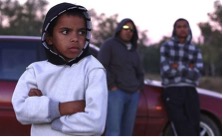
Shoulder-height handheld shot: the endogenous voice and vision. [53]

Toomelah from on high: Sen’s allogenous voice and vision. [54]
Resurrecting Borders
In this last section of my article, I return to the issue of the First Nations of Australia whose culture, in particular their language, is extinct or endangered, and their borders. As I mentioned earlier, in recent years, both as a discipline and a practice, film has been infused by an expanded attention towards dismantling and blurring borders. Sen’s film, however, makes the case for the need to rethink borders and perhaps to resurrect them. This throws into reverse the direction in which the border-blurring “spatial turn” has taken contemporary film theorists, critics and filmmakers. My argument is that the film is an example of what Rumford calls “bordering practice” as it suggests that we rethink borders “as mechanisms not of division, but of connectivity and encounter, where ‘connection does not by definition take place at the expense of borders but rather as a result of them.’” [55]
The historical dismantling of geographical borders between Indigenous nations, distinct social and language groups, has been part of the colonising process since the British arrived in 1788. The persistent destruction of Indigenous national, tribal and language borders is part of what Damien Short calls “continuing, cultural genocide” – a term that denotes the continuing undermining of a people’s way of life. [56] As legal and Indigenous Studies scholar Larissa Behrendt argues, while not recognised in international law, cultural genocide nonetheless ‘adequately describes [contemporary Aboriginal] experience as colonised peoples’. [57] It is precisely this experience that Toomelah depicts.
In an early scene, gang leader Linden talks to Daniel about how 50 years ago his own aunty “got taken away.” They were told she was being taken to the dentist: “She’s been gone for 50 years. It’s a long trip to the dentist, eh?” He goes on to tell Daniel how the old people used to hold corroborees at the river and spoke in their own language until the mission manager stopped them and punished them for it. [58] Like the rest of the characters – apart from the Elder who teaches the Gamilaroi language at the school – neither Linden nor Daniel can speak any more than a handful of words in their own language. Similarly, their traditional customs are foreign or lost to them. [59] The loss of Indigenous languages in Australia began when the traditional borders were denied by the declaration of terra nullius and then ignored or dismantled after the many bloody battles between white settlers and Indigenous peoples.
Conclusion
By the end of the film, Daniel has some serious thinking to do and a difficult decision to take. The choice before him is stark. Does he remain an outsider to learning and the school from which he has been expelled? Does he join Linden to become an insider only to a criminal gang and eventually, inevitably, to a jail? Or does he cross the road and return to school where he might stand a chance of learning his own language and thus help maintain it and his nation’s existence and thus, arguably, contribute to Australia’s diverse culture and society? In Sen’s story, Daniel chooses to cross back over the road and return to school: the film’s exogenous voice – Sen’s vision of the future – tells us that it is only here that Daniel can learn to resurrect the cultural traditions of his people and retrieve or re-draw the borders of his First Nation from the shifting grains of sand. Little Daniel needs to backtrack.
The images of criss-crossing tracks shot from up high (see below) from Toomelah symbolise Sen’s own tracks back and forth across borders that once existed and that his film points towards the necessity of rethinking and resurrecting. They invite the audiences’ perspective – the third, allogenous voice and vision – and demonstrate that borders need not necessarily be the project of the state but “can link people to the world beyond the ‘local’ border.” [60] It is this respect for both local and the wider, national and global values that confirms Toomelah’s cosmopolitanism and which justifies its inclusion in sojourner cinema.
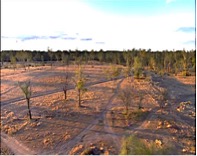
Criss-crossing tracks in Toomelah (Sen 2011)
Critical Border Studies theorists Noel Parker and Nick Vaughan-Williams remind us that “borders are memories of past and present violences etched into social landscapes, which are often concealed – or “sutured”. [61] However, there is no concealing or suturing in these images of Sen’s. They point to the act of creating the film Toomelah as a “bordering practice.” [62] This is an activity outlined by Parker and Rebecca Adler-Nissen as one that has “the effect … of constituting, sustaining, or modifying borders”. [63] By coming from the outside to visit, and staying for as long as it took to make his film in and about the people and place of Toomelah, Sen’s film tells us that “borders are also sites of [cosmopolitan] “cultural encounter” rather than simply a mechanism of division and exclusion.” [64] Toomelah pushes the very borders of sojourner cinema by offering a cosmopolitan world view which, although the colonial ‘sutures’ remain “living after-traces of past violence”, borders are shown to be what could “knit the world together”. [65] Sen can be understood as a sojourner in his own nation engaged in a practice that frames borders as a site of potential cultural encounter rather than of exclusion.
Acknowledgments: I wish to acknowledge the traditional owners of the lands on which I researched and wrote this article. I am deeply grateful to the people of Toomelah, the staff and pupils of Toomelah Public School, in particular Executive Principal Margaret Sloan, and Community Engagement Leader Carl McGrady for their warm hospitality. I thank the School of the Media and Arts at UNSW, Australia for awarding me Study Leave that enabled me to travel to Toomelah and the School of English, Media Studies & Art History at the University of Queensland who made me welcome during my study leave, in particular Professor Jason Jacobs, Professor Tom O’Regan and Associate Professor Jane Stadler. I thank Screening the Past Editor Anna Dzenis and the two thoughtful peer reviewers for their helpful feedback. Above all, I thank Ivan Sen who generously gave up a day of rest while in pre-production to show me his Toomelah. More than anything this enabled me to see Toomelah unframed by camera or narrative and experience for myself the value of an outsider’s sojourn for understanding and appreciating the contingent overlapping, fusions and juxtapositions of sounds, colours, ideas, words, emotions and images that offered me a new way of thinking about his film and, more generally, about First Nation cinema.
Endnotes
[1] Various alternative spellings exist for Gamilaroi, such as Gomeroi, Gamilaroi, Gumillaroy, Kamilaroi and Comelroy, all of which are attempts at transliteration to the Latin alphabet.
[2] Laura U. Marks, 2000, The Skin of the Film: Intercultural Cinema, Embodiment, and the Senses, Durham: Duke University Press, p. 24.
[3] Source: http://www.toomelahthemovie.com
[4] Jane Mills, 2013, ‘Sojourner Cinema: Seeking and Researching a New Cinematic Category.’ Framework: The Journal of Cinema & Media. 55:1, pp. 140-164.
[5] Kwame Appiah, 2006, Cosmopolitanism: Ethics in a World of Strangers. NY: WW Norton.
a href=”#_ednref6″>[6] Spelling of ‘Indigenous’ and ‘Aboriginal’, which I use interchangeably in this article, capitalizes these two terms when referring to the original inhabitants and traditional custodians of the land in Australia.
[7] Hamid Naficy, 2001, An Accented Cinema: Exilic and Diasporic Filmmaking, Princeton, NJ:
Princeton University Press; Marks, 2000.
[8] Marks, 2000, p. 24.
[9] See Toby Miller, 2010, ‘Culture + Labour – Precariat’, Communication and Critical/Cultural Studies. 7:1, pp. 96-99.
[10] Chris Rumford, 2012, ‘Towards a Multiperspectival Study of Borders’, Geopolitics, 17:4, p. 897.
[11] Bertrand Westphal, 2011, Geocriticism: Real and Fictional Spaces. Trans. Robert T. Tally Jr. NY: Palgrave Macmillan.
[12] Westphal, 2011, pp. 128-129.
[13] Thomas Elsaesser, 2005, ‘Double Occupancy and Small Adjustments”, in European Cinema: Face to Face with Hollywood, Amsterdam: University of Amsterdam Press, pp. 108-131; Naficy, 2001; Marks, 2000.
[14] Personal correspondence: March 2014.
[15] The Gamilaroi (Kamilaroi) people originally inhabited an area extending from around Singleton in the Hunter Valley through to the Warrumbungle Mountains in the west and up through centres of Quirindi, Tamworth, Narrabri, Walgett, Moree, Lightning Ridge and Mungindi in present day New South Wales, to Nindigully in south-west Queensland.
[16] Rumford, 2012, p. 887.
[17] Peter Robb, 2011, ‘A Journey through North-western NSW with Filmmaker Ivan Sen’, The Monthly, November. http://www.themonthly.com.au/issue/2011/november/1326604262/peter-robb/journey-through-north-western-nsw-filmmaker-ivan-sen (accessed 19 June 2015).
[18] The Bigambul are also known as: Bigabul, Pikambul, Bigambal, Bigambel, Bee-gum-bul, Bigumble, Pikumbul, Pikumpal, Pikambal, Pikum-bul, Pickum-bul, Pickimbul, Pickumble, Picum-bul, Pikumbil, Begumble, Peekumble, Pickumbil, Picumbill, Preagalgh, Wigal-wollumbul, Wee-n’ gul-la-m’ bul. The Bigambul people traditionally inhabited a 26,500 square km area to the north and north east of the Gamilaroi nation.
[19] For more on Indigenous languages, see http://www.ourlanguages.net.au/languages.html (accessed 4 June 2015). See also John Giacon, A grammar of Yuwaalaraay and Gamilaraay: A description of two New South Wales languages based on 160 years of records. A thesis submitted for the degree of Doctor of Philosophy of The Australian National University. October, 2014. At https://www.academia.edu/9168669/PhD_A_grammar_ of_Yuwaalaraay_and_ Gamilaraay_ a_description_of_two_New_South_Wales_languages_based_on_160_years_of_records (accessed 4 June 2015).
[20] Source: http://www1.aiatsis.gov.au/aseda/WWWVLPages/AborigPages/LANG/GAMDICT/ GAMDICT.HTM
[21] Source: http://www.alsnswact.org.au/pages/nsw
[22] The language of the Gamilaroi people is known as Gamilaraay and is classified in the Pama–Nyungan family of Australian languages.
[23] Source: http://black-australia.tumblr.com/post/80144093444/gixibyte-pull-out-poster-of-indigenous-first
[24] B. Gammage, 2011, The Biggest Estate on Earth: How Aboriginies Made Australia. Sydney: Allen & Unwin, p. 143.
[25] Gammage, 2011, p. 140. The blurb for Dawson’s recently republished book gives the following description: “Essentially a field-inspired anthropological account of the dwindling Aboriginal population, written before the emergence of anthropology as a formal discipline, Dawson’s book draws on his daughter’s ability to speak the local languages and attempts a balanced description of a culture he considered ill-used and under-appreciated by white settlers. Minute details about clothing, tools, settlement and beliefs combine to depict a complex society that possessed highly ritualised customs deserving of respect. Dawson also included an extensive vocabulary of words in three indigenous languages that he hoped would facilitate further cross-cultural understanding. His work provides valuable source material for modern researchers in anthropology and linguistics” (Cambridge: Cambridge University Press, 2009).
[26] Eyre, cited in Gammage, 2011, p. 141.
[27] D.B. Rose, 1996, Nourishing Terrains: Australian Aboriginal Views of Landscape and Wilderness. Canberra: Australian Heritage Commission, p. 38. http://www.environment.gov.au/system/files/resources/62db1069-b7ec-4d63-b9a9-991f4b931a60/files/nourishing-terrains.pdf. Accessed: 10 June 2015.
[28] Gammage, 2011:140
[29] Terra nullius is a Latin expression deriving from Roman law meaning “land belonging to no one”. It is used in international law to describe territory which has never been subject to the sovereignty of any state, or over which any prior sovereign has expressly or implicitly relinquished sovereignty.
[30] See UNESCO Atlas of the World’s Languages in Danger at http://www.unesco.org/languages-atlas/index.php (accessed 11 June 2015).
[31] ‘Toomelah Lesson’ Sydney Morning Herald, 21 June 2008 (accessed 1 October 2014). http://www.smh.com.au/news/national/toomelah-lesson/2008/06/20/1213770924233.html
[32] Photo: Read Brendaw. Source: www.goondiwindiargus.com.au
[33] ‘Time for tears is past: threat to disband black settlement’ Sydney Morning Herald, http://www.smh.com.au/nsw/time-for-tears-is-past-threat-to-disband-black-settlement-20120506-1y76p.html (accessed 10 June 2015). See also the ABC 7.30 Report at http://www.abc.net.au/7.30/content/2012/s3513824.htm (accessed 10 June 2015).
[34] http://www.parliament.nsw.gov.au/prod/parlment/hansart.nsf/V3Key/LA20120816109?open&ref NavID=HA8_1 (accessed 10 June 2015).
[35] The populations of Toomelah and Boggabilla are fluid with residents frequently coming and going. For the 2011 NSW Government community portrait of Toomelah and nearby Boggabilla see http://aboriginalaffairs.nsw.gov.au/wp-content/uploads/2013/09/130910-Community-Portrait-Toomelah-Boggabilla.pdf (accessed 4 June 2015).
[36] Source: Photo: Jane Mills.
[37] The only other Australian director to make more feature films in this period is Rolf De Heer.
[38] Peter Robb, 2011.
[39] Source: http://rightnow.org.au/artwork/film-toomelah/
[40] Mike Walsh, cited in Jane Mills, 2009, ‘Loving and Hating Hollywood: Reframing global and local cinemas, Crows Nest: Allen & Unwin, p.158.
[41] Sharon Verghis, 21 September 2013 ‘Outsider knowledge in Ivan Sen’s Mystery Road’: http://www.theaustralian.com.au/arts/review/outsider-knowledge-in-ivan-sens-mystery-road/story-fn9n8gph-1226722789111 (accessed 19 June 2015).
[42] Source: http://www.toomelahthemovie.com
[43] Source: http://www.mysteryroadmovie.com
[44] Verghis, 2013.
[45] Source: http://www.abc.net.au/local/photos/2013/10/06/3863288.htm
[46] See Human Rights and Equal Opportunity Commission, 16997, Bringing Them Home: Report of the National Enquiry into the Separation of Aboriginal and Torres Straits Islander Children from Their Families. Commonwealth of Australia: Canberra
[47] Source: http://www.toomelahthemovie.com
[48] Verghis, 2013.
[49] Geertz, Clifford, November 1998, ‘Deep Hanging Out’, New York Review of Books.
[50] James Clifford, 1997, Routes: Travel and Translation in the Late Twentieth Century (Cambridge MA: Harvard University Press.
[51] Michael Jackson, 2007, Excursions Durham NC: Duke University Press, p. xxvi.
[52] Westphal, 2011, pp. 128-129.
[53] Source: http://www.toomelahthemovie.com
[54] Source: http://www.toomelahthemovie.com
[55] Anthony Cooper and Chris Rumford, 2013, ‘Monumentalizing the Border: Bordering Through Connectivity’, cited in Tim Richardson (ed), “Borders and Mobilities: Introduction to the Special Issue, Mobilities, 8:1.
[56] Damien Short, 2010, ‘Australia: A continuing genocide?’, Journal of Genocide Research, 12:1-2, pp .45-68.
[57] Larissa Behrendt, 2002, ‘Genocide: the distance between law and life.’, Aboriginal History, 25, pp. 132-147. http://press.anu.edu.au/wp-content/uploads/2011/05/ch0843.pdf (accessed 10 June 2015).
[58] The word corroboree was first used by early European invaders to describe Aboriginal ceremonies that involved singing and dancing. Corroboree was the English version of an Aboriginal word, ‘caribberie’. Source: http://www.indigenousaustralia.info/culture/corroborees-a-ceremonies.html (accessed 19 June 2015).
[59] This and two other scenes can be viewed at http://aso.gov.au/titles/features/toomelah/clip1/ (accessed 11 June 2015).
[60] Chris Rumford, 2012, p. 887.
[61] Noel Parker and Nick Vaughan-Williams, 2009, ‘Lines in the sand? Towards an agenda towards critical border studies, Geopolitics, 14:3, pp 582-587.
[62] Noel Parker and Nick Vaughan-Williams (eds), 2013, Critical Border Studies: Broadening and deepening the ‘lines in the Sand’ Agenda, London: Routledge.
[63] Noel Parker and Rebecca Adler-Nissen, 2012, ‘Picking and Choosing the ‘Sovereign’ Border: A Theory of Changing State Bordering Practices’, Geopolitics, 17: 4, pp. 773-796.
[64] Chris Rumford, 2013, cited in Parker and Vaughan-Williams.
[65] Parker & Vaughan-Williams, 2013 ‘Introduction’.
